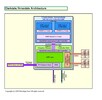Intel Core i5-430M vs Intel Core 2 Duo SU9600 vs Intel Core 2 Duo P7450
Intel Core i5-430M
► remove from comparison
Der Intel Core i5-430M ist ein zwei-Kern Prozessor für Notebooks und taktet dank Turbo mit 2.26 - 2.53 GHz. Die zwei Kerne basiert auf die Westmere (Nehalem ) Mikro-Architektur und können dank Hyperthreading 4 Threads gleichzeitig abarbeiten. Im Vergleich zu teureren Core i5 Modellen (wie dem 520M), fehlt dem 430M die Unterstützung für Virtualization Technology for Directed I/O (VT-d), Trusted Execution Technology, und AES New Instructions.
Eine Besonderheit der neuen Dual-Core CPUs von Intel ist die Integration des Speichercontrollers und einer integrierten Grafikkarte (GMA HD) in das Package. Die CPU wird bereits in 32nm hergestellt, der Speichercontroller und die Grafikkarte im Package jedoch noch in 45nm.
Bei der Performance kann der relativ günstige Core i5 430M stark punkten. Dank integriertem Speicherkontroller in dem Prozessorpackage, verbessertem HyperThreading und Turbo Boost, schlägt der 430M einen gleichgetakteten Core 2 Duo in allen Testbereichen. Der i5-430M kann sich in manchen Teilbereichen sogar an die Performance eines 2.8 GHz Core 2 Duo T9600 annähern (Cinebench Multi Core Rendering, 3DMark06 CPU Benchmark z.B.). Daher definiert Intel mit dem i5-430M die neue schnelle Mittelklasse von Dual-Core Prozessoren. Die Performance liegt im Vergleich zum derzeit schnellsten Turion II Ultra M660 deutlich höher und sollte daher für die meisten aktuellen Spiele und Applikationen genügend Rechenleistung bereitstellt.
Die 32-nm-Prozessorkerne der Westmere-Generation verarbeiten auch einige neue Befehle, die AES-Verschlüsselung beschleunigen sollen. Der i5-430M unterstützt diese Befehle jedoch nicht und ist dadurch bei manchen Teilbereichen deutlich langsamer als z.B. der Core i5-530M (z.B. in dem Communication Suite Test des PCMark Vantage gewinnt der i5-520M 70% Geschwindigkeit dank AES).
Die integrierte Intel Graphics Media Accelerator HD (GMA HD) Grafikkarte ist mit 500-766 MHz getaktet werden (mit Turbo Boost) und deutlich schneller werden als die alte GMA 4500MHD. Eine GeForce 9400M (ION) wird jedoch noch minimal schneller bleiben (mit besserem Treibersupport für Spiele). Der Turbo Boost Modus kann auch den Grafikkern übertakten, jedoch nur wenn der Prozessor nicht voll ausgelastet ist.
Der im Package integrierte Dual Channel DDR3 Speicherkontroller bietet eine max. Bandbreite von 17.1 GB/s und unterstützt DDR3-800 und 1066 (keine ECC Module).
Der Stromverbrauch ist mit einem TDP von 35 Watt (25 W CPU, 15 W GPU + Speicherkontroller) zwar genauso hoch wie bei den T-Modellen der Core 2 Duo Serie, jedoch beinhaltet der TDP beim Core i5 auch die Grafikkarte und den Speichercontroller (beim Core 2 Duo waren diese noch im Chipsatz). Dadurch ist der Stromverbrauch des ganzen Systems wohl geringer und mit einemm System mit sparendem P-Core 2 Duo vergleichbar.
Intel Core 2 Duo SU9600
► remove from comparisonDer Intel Core 2 Duo SU9600 ist ein stromsparender Prozessor für Subnotebooks. Er basiert auf den Penryn-3M Kern und bietet daher 3MB Level 2 Cache und wird in 45nm gefertigt. Er bietet alle Features des Penryn Kerns, wie Virtualisierung und Trusted Execution. Die Performance ist durch die geringe Taktrate etwas begrenzt.
Intel Core 2 Duo P7450
► remove from comparisonDer Intel Core 2 Duo P7450 Dual-Core Prozessor bietet zwei Prozessorkerne mit einem gemeinsamen Level 2 Cache von 3 MB. Dank 25 Watt TDP, eignet sich der Notebook Prozessor auch für 13" Notebooks. Im Vergleich zu stärkeren Penryn Core 2 Duo, bietet der P7450 keine Virtualisierungsfunktionen und keine Unterstützung für Trusted Execution Technology.
Für Multimediaanwendungen und anspruchslose Spiele, sollte die Performance des Intel Core 2 Duo P7450 ausreichen.
Der Penryn (Montevina Update) Kern bietet 2 Integer Units, 1 Floating Point Unit, 1 Load Unit und 1 Store Unit in einer 14-stufigen Pipeline. Mit der Wide Dynamic Execution Technologie kann der Kern bis zu vier volle Instruktionen gleichzeitig ausführen.
Das integrierte Enhanced Speedstep kann die Taktfrequenz des Prozessors dynamisch an die Leistungsanforderungen anpassen. Dadurch läuft die CPU ohne Last nur mit 800 MHz.
| Model | Intel Core i5-430M | Intel Core 2 Duo SU9600 | Intel Core 2 Duo P7450 | ||||||||||||||||||||||||||||||||||||||||||||||||||||
| Series | Intel Core i5 | Intel Core 2 Duo | Intel Core 2 Duo | ||||||||||||||||||||||||||||||||||||||||||||||||||||
| Codename | Arrandale | Penryn | Penryn | ||||||||||||||||||||||||||||||||||||||||||||||||||||
| Serie: Core 2 Duo Penryn |
| ||||||||||||||||||||||||||||||||||||||||||||||||||||||
| Clock | 2260 - 2533 MHz | 1600 MHz | 2130 MHz | ||||||||||||||||||||||||||||||||||||||||||||||||||||
| FSB | 2500 | 800 | 1066 | ||||||||||||||||||||||||||||||||||||||||||||||||||||
| L1 Cache | 128 KB | 128 KB | |||||||||||||||||||||||||||||||||||||||||||||||||||||
| L2 Cache | 512 KB | 3 MB | 3 MB | ||||||||||||||||||||||||||||||||||||||||||||||||||||
| L3 Cache | 3 MB | ||||||||||||||||||||||||||||||||||||||||||||||||||||||
| Cores / Threads | 2 / 4 | 2 / 2 | 2 / 2 | ||||||||||||||||||||||||||||||||||||||||||||||||||||
| TDP | 35 Watt | 10 Watt | 25 Watt | ||||||||||||||||||||||||||||||||||||||||||||||||||||
| Transistors | 177 Million | 410 Million | 410 Million | ||||||||||||||||||||||||||||||||||||||||||||||||||||
| Technology | 32 nm | 45 nm | 45 nm | ||||||||||||||||||||||||||||||||||||||||||||||||||||
| Die Size | 144 mm2 | 107 mm2 | 107 mm2 | ||||||||||||||||||||||||||||||||||||||||||||||||||||
| max. Temp. | 105 °C | 105 °C | 90 °C | ||||||||||||||||||||||||||||||||||||||||||||||||||||
| Socket | BGA1288, PGA988 | BGA956 | PGA478 | ||||||||||||||||||||||||||||||||||||||||||||||||||||
| Features | Turbo Boost, Hyper Threading, Enhanced Speedstep, integrierte GMA HD 500-733MHz, SSE4.1, SSE4.2 | Enhanced Speedstep, VT, TXT | Intel 64, Enhanced Speedstep, Execute Disable Bit | ||||||||||||||||||||||||||||||||||||||||||||||||||||
| Architecture | x86 | x86 | x86 | ||||||||||||||||||||||||||||||||||||||||||||||||||||
| Announced | |||||||||||||||||||||||||||||||||||||||||||||||||||||||
| Manufacturer | ark.intel.com | ark.intel.com | ark.intel.com | ||||||||||||||||||||||||||||||||||||||||||||||||||||
| Voltage | 0.775-1.1V V | 1.05-1.15V V | |||||||||||||||||||||||||||||||||||||||||||||||||||||
| $289 U.S. |


 Deutsch
Deutsch English
English Español
Español Français
Français Italiano
Italiano Nederlands
Nederlands Polski
Polski Português
Português Русский
Русский Türkçe
Türkçe Svenska
Svenska Chinese
Chinese Magyar
Magyar
